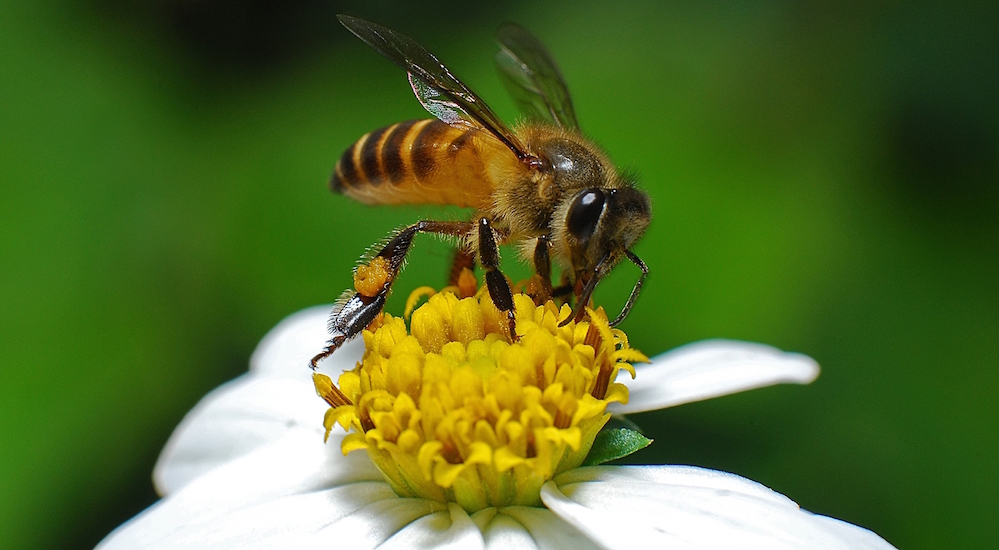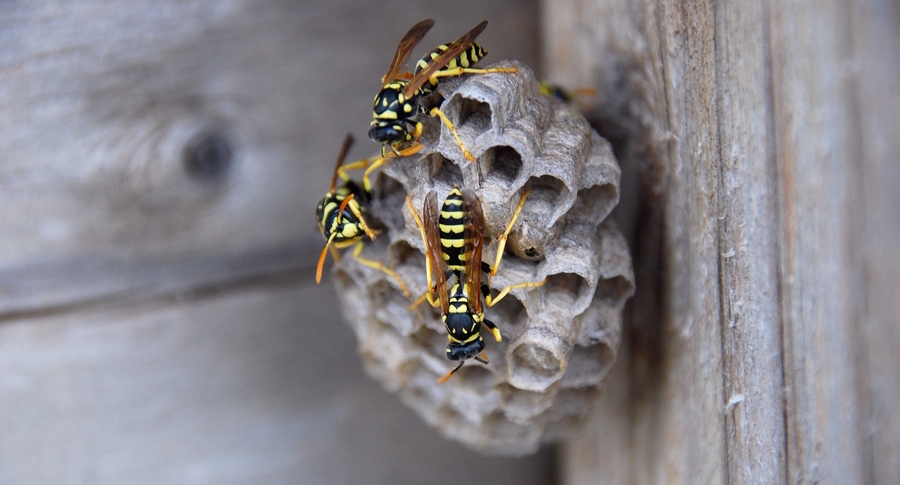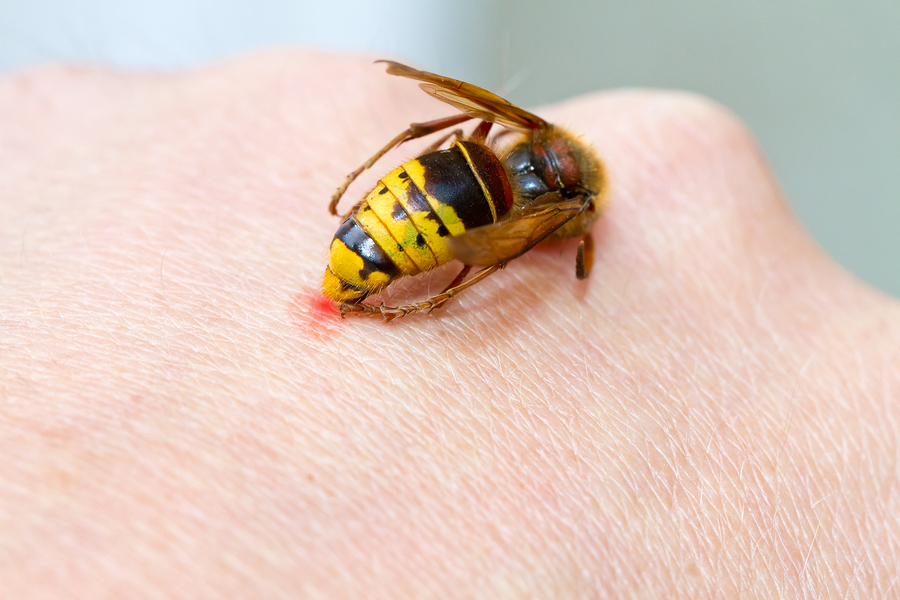READY TO GET STARTED?
REQUEST A FREE ESTIMATE
Fill out the form below or call (888) 466-7849 for a free, no-obligation estimate.

According to the AJC, the city of Decatur is now an official safe haven for bees, which was announced during National Pollinator Week (June 20-26) – designated as a time to celebrate pollinators and spread awareness on how we can all help to protect them from declining populations, including bees, birds, butterflies, bats and beetles.
On Monday this week, city officials voted to adopt a resolution that designates Decatur as a “Bee City“, the first official bee city in the state of Georgia. As part of this designation, the city agrees to celebrate National Pollinator Week, host educational events, and plant & restore sustainable bee habitats. Decatur will also install a Bee City USA street sign in a prominent location, in recognition of the city’s effort and participation.
This initiative is part of the city’s larger plan to support urban gardening, according to Mayor Patti Garrett. “Bees are of critical importance to gardens,” Garrett said.
According to Bee City USA, being a Bee City is a way for city leaders to improve their communities’ environment, eating habits, and overall economy by:

According to the AJC, the city of Decatur is now an official safe haven for bees, which was announced during National Pollinator Week (June 20-26) – designated as a time to celebrate pollinators and spread awareness on how we can all help to protect them from declining populations, including bees, birds, butterflies, bats and beetles.
On Monday this week, city officials voted to adopt a resolution that designates Decatur as a “Bee City“, the first official bee city in the state of Georgia. As part of this designation, the city agrees to celebrate National Pollinator Week, host educational events, and plant & restore sustainable bee habitats. Decatur will also install a Bee City USA street sign in a prominent location, in recognition of the city’s effort and participation.
This initiative is part of the city’s larger plan to support urban gardening, according to Mayor Patti Garrett. “Bees are of critical importance to gardens,” Garrett said.
According to Bee City USA, being a Bee City is a way for city leaders to improve their communities’ environment, eating habits, and overall economy by:

[vc_row css=”.vc_custom_1461783466399{margin-bottom: 20px !important;}”][vc_column][vc_column_text]
Now that we’re well into the Spring season, you may be noticing an influx of pests that were hiding out over the winter – mosquitoes, ants, termites, and BEES. While some bees you’ll encounter are harmless, others can seem threatening and leave behind painful stings and cause allergic reactions. Here’s a list of common bees in the South to be on the lookout during the Spring and Summer seasons, with bee control tips:
[/vc_column_text][/vc_column][/vc_row][vc_row css=”.vc_custom_1461783788041{margin-bottom: 20px !important;}”][vc_column][vc_row_inner][vc_column_inner][ctitle title=”Carpenter Bees” uppercase=”no” background=”#ffffff” font_size=”26″ position=”left” separator_color=”#ffffff”][/vc_column_inner][/vc_row_inner][vc_separator style=”blank” padding_top=”5″ padding_bottom=”5″][vc_row_inner][vc_column_inner width=”1/3″][vc_single_image image=”15376″ img_size=”300×155″ style=”vc_box_outline” img_link_target=”_blank” link=”https://www.callnorthwest.com/identify-pest/bees/carpenter-bees/”][/vc_column_inner][vc_column_inner width=”2/3″][vc_column_text]
Carpenter bees are large black and yellow bees, often mistaken for bumble bees. You’re likely to see them in the Spring hovering around the eaves of your house or under and around decks and porches. Carpenter bees can cause damage to structures by creating small, circular holes as entry points into nests with multiple tunnels, leaving behind trails of sawdust. Any area of exposed wood can be a target for carpenter bee nests. The good news: carpenter bees rarely sting unless bothered; males do not have a stinger but can become aggressive towards other bees, animals or people near their nest and females usually only sting when extremely agitated. You can also prevent carpenter bees from nesting by treating or painting any exposed wood. If you’re already seeing carpenter bee nests, each nest hole should be treated with a pesticide if bees are inside the nest. If no bees are in the nest, seal or paint entry holes. For best results, call a pest control company that specializes in bee control and removal.
[/vc_column_text][/vc_column_inner][/vc_row_inner][/vc_column][/vc_row][vc_row css=”.vc_custom_1461783795963{margin-bottom: 20px !important;}”][vc_column][vc_row_inner][vc_column_inner][ctitle title=”Cicada Killer Bees” uppercase=”no” background=”#ffffff” font_size=”26″ position=”left” separator_color=”#ffffff”][/vc_column_inner][/vc_row_inner][vc_separator style=”blank” padding_top=”5″ padding_bottom=”5″][vc_row_inner][vc_column_inner width=”1/3″][vc_single_image image=”15377″ img_size=”300×155″ style=”vc_box_outline” img_link_target=”_blank” link=”https://www.callnorthwest.com/identify-pest/bees/cicada-killer-bees/”][/vc_column_inner][vc_column_inner width=”2/3″][vc_column_text]
Cicada killer bees are large bees, black or rusty-colored with yellow markings, that resemble a larger version of a yellow jacket. Unlike a lot of other bee species, cicada killer bees do not live in colonies and prefer to nest underground in areas of bare ground. Female cicada killer bees dig burrows 1/2″ in diameter that can extend up to 10″ deep which can cause significant lawn damage. You’re likely to encounter cicada killer bees in the Summer – usually July and August – when they emerge from burrows.
[/vc_column_text][/vc_column_inner][/vc_row_inner][/vc_column][/vc_row][vc_row css=”.vc_custom_1461783803707{margin-bottom: 20px !important;}”][vc_column][vc_row_inner][vc_column_inner][ctitle title=”Bumble Bees” uppercase=”no” background=”#ffffff” font_size=”26″ position=”left” separator_color=”#ffffff”][/vc_column_inner][/vc_row_inner][vc_separator style=”blank” padding_top=”5″ padding_bottom=”5″][vc_row_inner][vc_column_inner width=”1/3″][vc_single_image image=”15378″ img_size=”300×155″ style=”vc_box_outline”][/vc_column_inner][vc_column_inner width=”2/3″][vc_column_text]
While relatively harmless bees, bumble bees – identified by their fuzzy, black and yellow-striped appearance and a buzzing sound while flying – can become aggressive and sting if their nest is threatened. They’re normally seen in flowering plants and typically don’t nest in structures.
[/vc_column_text][/vc_column_inner][/vc_row_inner][/vc_column][/vc_row][vc_row css=”.vc_custom_1461783813281{margin-bottom: 20px !important;}”][vc_column][vc_row_inner][vc_column_inner][ctitle title=”Yellow Jackets” uppercase=”no” background=”#ffffff” font_size=”26″ position=”left” separator_color=”#ffffff”][/vc_column_inner][/vc_row_inner][vc_separator style=”blank” padding_top=”5″ padding_bottom=”5″][vc_row_inner][vc_column_inner width=”1/3″][vc_single_image image=”15379″ img_size=”300×155″ style=”vc_box_outline”][/vc_column_inner][vc_column_inner width=”2/3″][vc_column_text]
Yellow jackets are one of the most commonly encountered bees and also one of the most aggressive. Their stings can be extremely painful and cause severe allergic reactions for some. Yellow jackets are also know to sting repeatedly. Avoiding yellow jackets is the best method of sting prevention or remain still if you encounter them; swatting or sudden movements can cause them to attack.
[/vc_column_text][/vc_column_inner][/vc_row_inner][/vc_column][/vc_row][vc_row css=”.vc_custom_1461783821501{margin-bottom: 20px !important;}”][vc_column][vc_row_inner][vc_column_inner][ctitle title=”Paper Wasps” uppercase=”no” background=”#ffffff” font_size=”26″ position=”left” separator_color=”#ffffff”][/vc_column_inner][/vc_row_inner][vc_separator style=”blank” padding_top=”5″ padding_bottom=”5″][vc_row_inner][vc_column_inner width=”1/3″][vc_single_image image=”15381″ img_size=”300×155″ style=”vc_box_outline”][/vc_column_inner][vc_column_inner width=”2/3″][vc_column_text]
Paper wasps are large, aggressive wasps that cause painful bites and sometimes severe allergic reactions. They’re most likely to sting if their nest is threatened or disturbed. It’s recommended to contact an exterminating company for wasp nest removal.
[/vc_column_text][/vc_column_inner][/vc_row_inner][/vc_column][/vc_row][vc_row css=”.vc_custom_1461783548104{margin-bottom: 40px !important;}”][vc_column][vc_row_inner][vc_column_inner][ctitle title=”Hornets” uppercase=”no” background=”#ffffff” font_size=”26″ position=”left” separator_color=”#ffffff”][/vc_column_inner][/vc_row_inner][vc_separator style=”blank” padding_top=”5″ padding_bottom=”5″][vc_row_inner][vc_column_inner width=”1/3″][vc_single_image image=”15382″ img_size=”300×155″ style=”vc_box_outline”][/vc_column_inner][vc_column_inner width=”2/3″][vc_column_text]
Hornets are brown and yellow striped with reddish colored wings, and sometime mistaken for cicada killer bees. They build above-ground nests, usually in trees, and are active in the Spring. It’s recommended that you contact a pest control company to remove a hornet nest, but they do not pose a serious threat to humans and will die or hibernate in the Fall.
[/vc_column_text][/vc_column_inner][/vc_row_inner][/vc_column][/vc_row]

[vc_row css=”.vc_custom_1461783466399{margin-bottom: 20px !important;}”][vc_column][vc_column_text]
Now that we’re well into the Spring season, you may be noticing an influx of pests that were hiding out over the winter – mosquitoes, ants, termites, and BEES. While some bees you’ll encounter are harmless, others can seem threatening and leave behind painful stings and cause allergic reactions. Here’s a list of common bees in the South to be on the lookout during the Spring and Summer seasons, with bee control tips:
[/vc_column_text][/vc_column][/vc_row][vc_row css=”.vc_custom_1461783788041{margin-bottom: 20px !important;}”][vc_column][vc_row_inner][vc_column_inner][ctitle title=”Carpenter Bees” uppercase=”no” background=”#ffffff” font_size=”26″ position=”left” separator_color=”#ffffff”][/vc_column_inner][/vc_row_inner][vc_separator style=”blank” padding_top=”5″ padding_bottom=”5″][vc_row_inner][vc_column_inner width=”1/3″][vc_single_image image=”15376″ img_size=”300×155″ style=”vc_box_outline” img_link_target=”_blank” link=”https://www.callnorthwest.com/identify-pest/bees/carpenter-bees/”][/vc_column_inner][vc_column_inner width=”2/3″][vc_column_text]
Carpenter bees are large black and yellow bees, often mistaken for bumble bees. You’re likely to see them in the Spring hovering around the eaves of your house or under and around decks and porches. Carpenter bees can cause damage to structures by creating small, circular holes as entry points into nests with multiple tunnels, leaving behind trails of sawdust. Any area of exposed wood can be a target for carpenter bee nests. The good news: carpenter bees rarely sting unless bothered; males do not have a stinger but can become aggressive towards other bees, animals or people near their nest and females usually only sting when extremely agitated. You can also prevent carpenter bees from nesting by treating or painting any exposed wood. If you’re already seeing carpenter bee nests, each nest hole should be treated with a pesticide if bees are inside the nest. If no bees are in the nest, seal or paint entry holes. For best results, call a pest control company that specializes in bee control and removal.
[/vc_column_text][/vc_column_inner][/vc_row_inner][/vc_column][/vc_row][vc_row css=”.vc_custom_1461783795963{margin-bottom: 20px !important;}”][vc_column][vc_row_inner][vc_column_inner][ctitle title=”Cicada Killer Bees” uppercase=”no” background=”#ffffff” font_size=”26″ position=”left” separator_color=”#ffffff”][/vc_column_inner][/vc_row_inner][vc_separator style=”blank” padding_top=”5″ padding_bottom=”5″][vc_row_inner][vc_column_inner width=”1/3″][vc_single_image image=”15377″ img_size=”300×155″ style=”vc_box_outline” img_link_target=”_blank” link=”https://www.callnorthwest.com/identify-pest/bees/cicada-killer-bees/”][/vc_column_inner][vc_column_inner width=”2/3″][vc_column_text]
Cicada killer bees are large bees, black or rusty-colored with yellow markings, that resemble a larger version of a yellow jacket. Unlike a lot of other bee species, cicada killer bees do not live in colonies and prefer to nest underground in areas of bare ground. Female cicada killer bees dig burrows 1/2″ in diameter that can extend up to 10″ deep which can cause significant lawn damage. You’re likely to encounter cicada killer bees in the Summer – usually July and August – when they emerge from burrows.
[/vc_column_text][/vc_column_inner][/vc_row_inner][/vc_column][/vc_row][vc_row css=”.vc_custom_1461783803707{margin-bottom: 20px !important;}”][vc_column][vc_row_inner][vc_column_inner][ctitle title=”Bumble Bees” uppercase=”no” background=”#ffffff” font_size=”26″ position=”left” separator_color=”#ffffff”][/vc_column_inner][/vc_row_inner][vc_separator style=”blank” padding_top=”5″ padding_bottom=”5″][vc_row_inner][vc_column_inner width=”1/3″][vc_single_image image=”15378″ img_size=”300×155″ style=”vc_box_outline”][/vc_column_inner][vc_column_inner width=”2/3″][vc_column_text]
While relatively harmless bees, bumble bees – identified by their fuzzy, black and yellow-striped appearance and a buzzing sound while flying – can become aggressive and sting if their nest is threatened. They’re normally seen in flowering plants and typically don’t nest in structures.
[/vc_column_text][/vc_column_inner][/vc_row_inner][/vc_column][/vc_row][vc_row css=”.vc_custom_1461783813281{margin-bottom: 20px !important;}”][vc_column][vc_row_inner][vc_column_inner][ctitle title=”Yellow Jackets” uppercase=”no” background=”#ffffff” font_size=”26″ position=”left” separator_color=”#ffffff”][/vc_column_inner][/vc_row_inner][vc_separator style=”blank” padding_top=”5″ padding_bottom=”5″][vc_row_inner][vc_column_inner width=”1/3″][vc_single_image image=”15379″ img_size=”300×155″ style=”vc_box_outline”][/vc_column_inner][vc_column_inner width=”2/3″][vc_column_text]
Yellow jackets are one of the most commonly encountered bees and also one of the most aggressive. Their stings can be extremely painful and cause severe allergic reactions for some. Yellow jackets are also know to sting repeatedly. Avoiding yellow jackets is the best method of sting prevention or remain still if you encounter them; swatting or sudden movements can cause them to attack.
[/vc_column_text][/vc_column_inner][/vc_row_inner][/vc_column][/vc_row][vc_row css=”.vc_custom_1461783821501{margin-bottom: 20px !important;}”][vc_column][vc_row_inner][vc_column_inner][ctitle title=”Paper Wasps” uppercase=”no” background=”#ffffff” font_size=”26″ position=”left” separator_color=”#ffffff”][/vc_column_inner][/vc_row_inner][vc_separator style=”blank” padding_top=”5″ padding_bottom=”5″][vc_row_inner][vc_column_inner width=”1/3″][vc_single_image image=”15381″ img_size=”300×155″ style=”vc_box_outline”][/vc_column_inner][vc_column_inner width=”2/3″][vc_column_text]
Paper wasps are large, aggressive wasps that cause painful bites and sometimes severe allergic reactions. They’re most likely to sting if their nest is threatened or disturbed. It’s recommended to contact an exterminating company for wasp nest removal.
[/vc_column_text][/vc_column_inner][/vc_row_inner][/vc_column][/vc_row][vc_row css=”.vc_custom_1461783548104{margin-bottom: 40px !important;}”][vc_column][vc_row_inner][vc_column_inner][ctitle title=”Hornets” uppercase=”no” background=”#ffffff” font_size=”26″ position=”left” separator_color=”#ffffff”][/vc_column_inner][/vc_row_inner][vc_separator style=”blank” padding_top=”5″ padding_bottom=”5″][vc_row_inner][vc_column_inner width=”1/3″][vc_single_image image=”15382″ img_size=”300×155″ style=”vc_box_outline”][/vc_column_inner][vc_column_inner width=”2/3″][vc_column_text]
Hornets are brown and yellow striped with reddish colored wings, and sometime mistaken for cicada killer bees. They build above-ground nests, usually in trees, and are active in the Spring. It’s recommended that you contact a pest control company to remove a hornet nest, but they do not pose a serious threat to humans and will die or hibernate in the Fall.
[/vc_column_text][/vc_column_inner][/vc_row_inner][/vc_column][/vc_row]

School is almost back in session but summer is far from over here in the south. This means we have a few more months of summer pests to look forward to. Some of the most threatening: stinging pests. Yellowjackets, wasps, hornets and other common stinging insects can pose serious risks to our health and send more than half a million people to the emergency room every year, according to the National Pest Management Association. They often create painful stings and severe allergic reactions, and are likely lurking around outside, at BBQs, playgrounds, and pools. Minimize your risk by being aware. Here are the 4 most common stinging pests you should be on the lookout for.
1. Yellowjackets – Yellowjackets are distinguished by the black and yellow color pattern banded across their abdomens. They are territorial and may sting repeatedly if threatened.
2. European Hornets – European hornets are active at night. They have smooth stingers that carry venom known to cause itching, swelling and pain for about 24 hours. Like yellowjackets and wasps, European hornets can sting repeatedly during an attack.
3. Paper Wasps – Paper wasps are not an aggressive species by nature, but they will sting if their nest is threatened. Wasp stings are painful and can cause the same risk of allergic reaction as other insect stings.
4. Killer Bees – Africanized “killer” bees defend their colony and will attack in large numbers when threatened. However, they can only sting once as their stingers are barbed and tear off when trying to get away. Killer bees have been known to chase people for more than a quarter mile.
The best way to prevent an unwanted encounter is to exercise caution when outdoors. If you come in contact with a bee or wasp, do not swat it, as that may actually provoke an attack. Remain calm and the insect should fly away without causing harm. For bee infestations, contact your local pest control company.